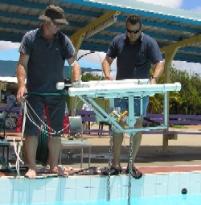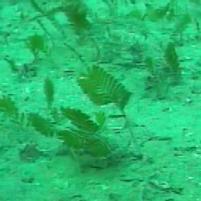Submersible camera to be used to monitor scallops
Published on 15 November, 2005
A submersible camera system developed by staff at CQU’s Centre for Environmental Management and Queensland Sea Scallop Ltd will help in the monitoring of scallops in Hervey Bay.
The development of the camera system was funded by a CQU collaborative grant and Queensland Sea Scallop Ltd, a company formed by scallop fishers and processors based at Burnett Heads, near Bundaberg.
 The camera system will be used to monitor the growth of juvenile scallops that are seeded into Hervey Bay as part of the Queensland Sea Scallop’s sea ranching program. However, the system is not limited to monitoring scallops, and would be useful for monitoring habitats on any soft or sandy bottom seafloors.
The camera system will be used to monitor the growth of juvenile scallops that are seeded into Hervey Bay as part of the Queensland Sea Scallop’s sea ranching program. However, the system is not limited to monitoring scallops, and would be useful for monitoring habitats on any soft or sandy bottom seafloors.
Marine Ecology researcher, Dr Peter Stratford said he and fellow CEM staff member, Andrew Davis, had been working on the design and construction of the camera for a number of weeks.
“The basic principle is based on existing models but with a number of modifications that will provide better visibility and cause less damage to the sea floor.
“Most submersible cameras are towed along the sea floor on a sled and that can cause a lot of damage and reduce visibility due to the sediment that is disturbed.
“Our system essentially uses a floating frame, buoyed up with cylindrical floats, which we then weigh down with chains. By using chains attached to the bottom of the frame, the whole system sinks until it reaches neutral buoyancy, allowing the camera to “hover” just above the seafloor. This helps ensure that any disturbance is minimal, with only the chains touching the seafloor. The damage caused by the chains is negligible,” said Dr Stratford.
The camera system has also been designed to be easily transported and operated by one person from a small boat and the images captured by the camera are recorded directly to DVD for later analysis.
 Early field trials with the system provided very positive results, with the images comparing favourably with much more expensive equipment, although some minor bugs in the system have had to be ironed out.
Early field trials with the system provided very positive results, with the images comparing favourably with much more expensive equipment, although some minor bugs in the system have had to be ironed out.
Dr Stratford and Mr Davis completed final testing on the camera at the Gladstone Aquatic Centre this week and said they were really happy with the results which indicated that no further modifications were needed at this stage.
Photo to left: Dr Peter Stratford and Andrew Davis prepare to test the submersible camera.
Photo Above: Images taken by the camera at Hervey Bay. The image shows seagrass meadows at about at 10 metre depth. The main species seen in the image is Halophila spinulosa which provides prime habitat for scallops.

